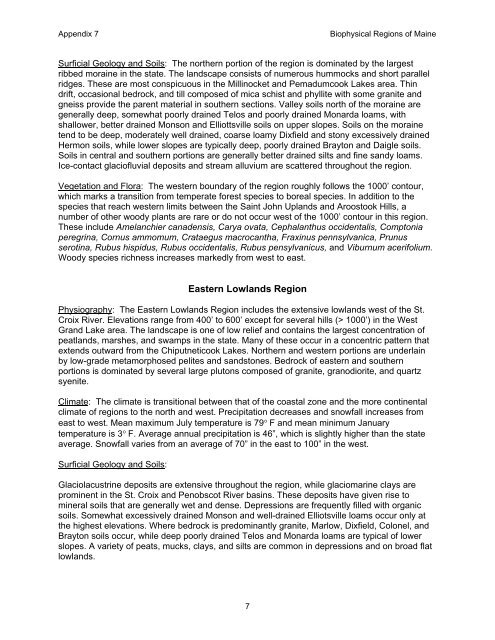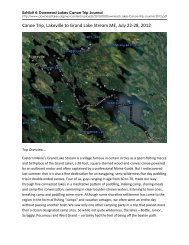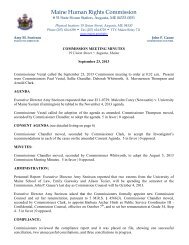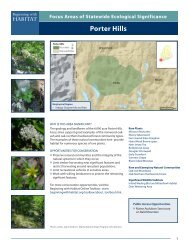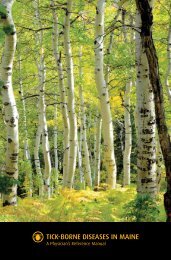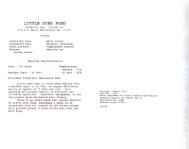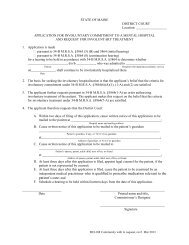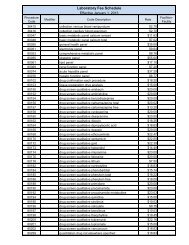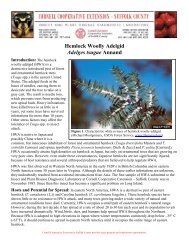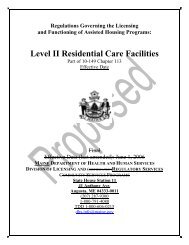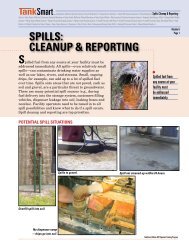BIOPHYSICAL REGIONS - Maine.gov
BIOPHYSICAL REGIONS - Maine.gov
BIOPHYSICAL REGIONS - Maine.gov
You also want an ePaper? Increase the reach of your titles
YUMPU automatically turns print PDFs into web optimized ePapers that Google loves.
Appendix 7 Biophysical Regions of <strong>Maine</strong><br />
Surficial Geology and Soils: The northern portion of the region is dominated by the largest<br />
ribbed moraine in the state. The landscape consists of numerous hummocks and short parallel<br />
ridges. These are most conspicuous in the Millinocket and Pemadumcook Lakes area. Thin<br />
drift, occasional bedrock, and till composed of mica schist and phyllite with some granite and<br />
gneiss provide the parent material in southern sections. Valley soils north of the moraine are<br />
generally deep, somewhat poorly drained Telos and poorly drained Monarda loams, with<br />
shallower, better drained Monson and Elliottsville soils on upper slopes. Soils on the moraine<br />
tend to be deep, moderately well drained, coarse loamy Dixfield and stony excessively drained<br />
Hermon soils, while lower slopes are typically deep, poorly drained Brayton and Daigle soils.<br />
Soils in central and southern portions are generally better drained silts and fine sandy loams.<br />
Ice-contact glaciofluvial deposits and stream alluvium are scattered throughout the region.<br />
Vegetation and Flora: The western boundary of the region roughly follows the 1000’ contour,<br />
which marks a transition from temperate forest species to boreal species. In addition to the<br />
species that reach western limits between the Saint John Uplands and Aroostook Hills, a<br />
number of other woody plants are rare or do not occur west of the 1000’ contour in this region.<br />
These include Amelanchier canadensis, Carya ovata, Cephalanthus occidentalis, Comptonia<br />
peregrina, Cornus ammomum, Crataegus macrocantha, Fraxinus pennsylvanica, Prunus<br />
serotina, Rubus hispidus, Rubus occidentalis, Rubus pensylvanicus, and Viburnum acerifolium.<br />
Woody species richness increases markedly from west to east.<br />
Eastern Lowlands Region<br />
Physiography: The Eastern Lowlands Region includes the extensive lowlands west of the St.<br />
Croix River. Elevations range from 400’ to 600’ except for several hills (> 1000’) in the West<br />
Grand Lake area. The landscape is one of low relief and contains the largest concentration of<br />
peatlands, marshes, and swamps in the state. Many of these occur in a concentric pattern that<br />
extends outward from the Chiputneticook Lakes. Northern and western portions are underlain<br />
by low-grade metamorphosed pelites and sandstones. Bedrock of eastern and southern<br />
portions is dominated by several large plutons composed of granite, granodiorite, and quartz<br />
syenite.<br />
Climate: The climate is transitional between that of the coastal zone and the more continental<br />
climate of regions to the north and west. Precipitation decreases and snowfall increases from<br />
east to west. Mean maximum July temperature is 79° F and mean minimum January<br />
temperature is 3° F. Average annual precipitation is 46”, which is slightly higher than the state<br />
average. Snowfall varies from an average of 70” in the east to 100” in the west.<br />
Surficial Geology and Soils:<br />
Glaciolacustrine deposits are extensive throughout the region, while glaciomarine clays are<br />
prominent in the St. Croix and Penobscot River basins. These deposits have given rise to<br />
mineral soils that are generally wet and dense. Depressions are frequently filled with organic<br />
soils. Somewhat excessively drained Monson and well-drained Elliotsville loams occur only at<br />
the highest elevations. Where bedrock is predominantly granite, Marlow, Dixfield, Colonel, and<br />
Brayton soils occur, while deep poorly drained Telos and Monarda loams are typical of lower<br />
slopes. A variety of peats, mucks, clays, and silts are common in depressions and on broad flat<br />
lowlands.<br />
7


